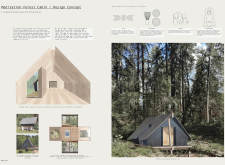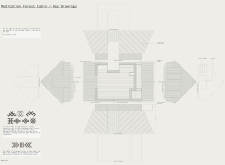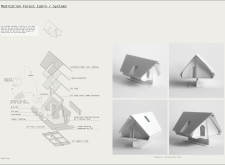5 key facts about this project
The design of the cabin integrates traditional Latvian architectural motifs with contemporary sensibilities. The steeply pitched roof not only reflects the cultural heritage but also efficiently manages environmental factors such as snow and rain. The choice of cross-laminated timber for the structural framework allows for both robust construction and aesthetic warmth, while hardwood timber cladding adds a natural, tactile quality to the exterior. This selection of materials underscores a commitment to sustainability, prioritizing local sourcing and environmentally-friendly practices. The use of rigid insulation further enhances the cabin's energy efficiency, ensuring comfort without compromising on eco-consciousness.
Inside, the cabin is organized to maximize openness and natural light, essential elements for promoting a meditative atmosphere. Large windows create a seamless connection between the interior and the surrounding forest, inviting the natural environment into the living space. This thoughtful placement of glazing encourages occupants to engage actively with nature, enhancing their meditation experience. The layout includes dedicated zones for relaxation, creative pursuits, and reflective practices, underscoring the multifunctional nature of the space. This intentional design encourages fluid movement throughout the cabin while allowing for moments of solitude.
One of the unique aspects of this architectural project is how it incorporates cultural narratives into a modern context. The cabin serves not only as a physical structure but as a dialogue between the past and present, intertwining Latvian folklore with the contemporary need for spaces dedicated to mindfulness. The architectural design captures these elements through its aesthetic choices and spatial organization, inviting visitors to reflect on their connection to heritage and the environment.
The Meditation Forest Cabin goes beyond mere architectural aesthetics; it embodies a lifestyle choice aimed at enhancing mental clarity and tranquility. It encourages occupants to immerse themselves fully in a retreat-like experience that promotes peace and sustainability. This project emphasizes the potential of architecture to influence emotional well-being through design principles rooted in simplicity and harmony with nature.
For those interested in exploring the nuances of this project further, reviewing the architectural plans, sections, and designs will provide deeper insights into the thoughtful approaches undertaken in crafting this soothing retreat. Delving into the architectural ideas that shaped this cabin offers an opportunity to appreciate the intricate relationship between space, nature, and the human need for mindfulness.


























